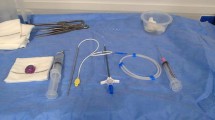Abstract
Purpose
With central venous catheterization, each additional vein puncture raises the risk of complications. We assessed the rate of failure and complications using a limiting rule whereby the number of needle passes for subclavian vein catheterization was restricted to three.
Methods
A prospective clinical trial was conducted between September 2001 and December 2003 in a university hospital surgical department. Two hundred and thirty-two adult patients were enrolled to undergo subclavian vein catheterization under non-emergency conditions. The patients were subjected to right subclavian vein catheterization by the infraclavicular approach. Vein puncture failure was defined as such if venipuncture was not accomplished after three attempts. Any arterial puncture was judged to be a failure immediately.
Results
Vein puncture failure occurred in nine patients (3.9%), and included two arterial punctures (0.9%). No other complications, such as pneumothorax, hemothorax, plexus lesion, mediastinal hematoma or bleeding, or air embolism, were observed. In multivariate analyses, a close to average body mass index (weight in kilograms divided by the square of the height in meters, odds ratio 0.74; 95% confidence interval 0.56–0.97; P = 0.028) was associated with a low risk of failure.
Conclusion
Limiting the number of needle passes to three may therefore prevent mechanical complications. A low body mass index was predictive of vein puncture failure.
Similar content being viewed by others
References
R Boyd A Saxe E Phillips (1996) ArticleTitleEffect of patient position upon success in placing central venous catheters Am J Surg 172 380–2 Occurrence Handle8873535 Occurrence Handle1:STN:280:DyaK2s%2FisleqtA%3D%3D Occurrence Handle10.1016/S0002-9610(96)00198-5
PF Mansfield DC Hohn BD Fornage MA Gregurich DM Ota (1994) ArticleTitleComplications and failures of subclavian-vein catheterization N Engl J Med 331 1735–8 Occurrence Handle7984193 Occurrence Handle1:STN:280:DyaK2M%2FnsFCjtw%3D%3D Occurrence Handle10.1056/NEJM199412293312602
NP O'Grady M Alexander EP Dellinger JL Gerberding SO Heard DG Maki et al. (2002) ArticleTitleGuidelines for the prevention of zintravascular catheter-related infections. Centers for Disease Control and Prevention MMWR Recomm Rep 51 IssueIDRR-10 1–29 Occurrence Handle12233868
J Merrer B De Jonghe F Golliot JY Lefrant B Raffy E Barre et al. (2001) ArticleTitleFrench Catheter Study Group in Intensive Care. Complications of femoral and subclavian venous catheterization in critically ill patients: a randomized controlled trial JAMA 286 700–7 Occurrence Handle11495620 Occurrence Handle1:STN:280:DC%2BD3MvmtFeisA%3D%3D Occurrence Handle10.1001/jama.286.6.700
DC McGee MK Gould (2003) ArticleTitlePreventing complications of central venous catheterization (review) N Engl J Med 348 1123–33 Occurrence Handle12646670 Occurrence Handle10.1056/NEJMra011883
S Ruesch B Walder MR Tramer (2002) ArticleTitleComplications of central venous catheters: internal jugular versus subclavian access — a systematic review Crit Care Med 30 454–60 Occurrence Handle11889329 Occurrence Handle10.1097/00003246-200202000-00031
V Puel M Caudry P Le Metayer JC Baste D Midy C Marsault et al. (1993) ArticleTitleSuperior vena cava thrombosis related to catheter malposition in cancer chemotherapy given through implanted ports Cancer 72 2248–52 Occurrence Handle8374884 Occurrence Handle1:STN:280:DyaK3szos1Kmuw%3D%3D Occurrence Handle10.1002/1097-0142(19931001)72:7<2248::AID-CNCR2820720731>3.0.CO;2-U
CA Czepizak JM O'Callaghan B Venus (1995) ArticleTitleEvaluation of formulas for optimal positioning of central venous catheters Chest 107 1662–4 Occurrence Handle7781364 Occurrence Handle1:STN:280:DyaK2MzgtVGhtA%3D%3D
AA Bankier R Mallek MN Wiesmayr D Fleischmann A Kranz M Kontrus et al. (1997) ArticleTitleAzygos arch cannulation by central venous catheters: radiographic detection of malposition and subsequent complications J Thorac Imaging 12 64–9 Occurrence Handle8989762 Occurrence Handle1:STN:280:DyaK2s7ktlOmsw%3D%3D Occurrence Handle10.1097/00005382-199701000-00010
DR Gentili D Onofrey GV Gabrielson E Benjamin TJ Iberti (1989) ArticleTitleMalposition of central venous catheters outside the central circulation J Cardiothorac Anesth 3 752–6 Occurrence Handle2521035 Occurrence Handle1:STN:280:DyaK38zivF2jsw%3D%3D Occurrence Handle10.1016/S0888-6296(89)95161-2
Author information
Authors and Affiliations
Rights and permissions
About this article
Cite this article
Takeyama, H., Taniguchi, M., Sawai, H. et al. Limiting Vein Puncture to Three Needle Passes in Subclavian Vein Catheterization by the Infraclavicular Approach. Surg Today 36, 779–782 (2006). https://doi.org/10.1007/s00595-006-3259-9
Received:
Accepted:
Issue Date:
DOI: https://doi.org/10.1007/s00595-006-3259-9




